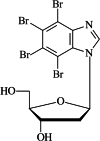Antitumor activity of the protein kinase inhibitor 1-(β-D-2'-deoxyribofuranosyl)-4,5,6,7-tetrabromo- 1H-benzimidazole in breast cancer cell lines
- PMID: 36243702
- PMCID: PMC9571492
- DOI: 10.1186/s12885-022-10156-8
Antitumor activity of the protein kinase inhibitor 1-(β-D-2'-deoxyribofuranosyl)-4,5,6,7-tetrabromo- 1H-benzimidazole in breast cancer cell lines
Abstract
Background: The protein kinases CK2 and PIM-1 are involved in cell proliferation and survival, the cell cycle, and drug resistance, and they are found overexpressed in virtually all types of human cancer, including breast cancer. In this study, we investigated the antitumor activity of a deoxynucleoside derivative, the protein kinase inhibitor compound 1-(β-D-2'-deoxyribofuranosyl)-4,5,6,7-tetrabromo-1H-benzimidazole (K164, also termed TDB), inter alia CK2 and PIM-1, on breast cancer cell lines (MDA-MB-231, MCF-7, and SK-BR-3).
Methods: An evaluation of the cytotoxic and proapoptotic effects, mitochondrial membrane potential (ΔΨm), and cell cycle progression was performed using an MTT assay, flow cytometry, and microscopic analysis. The Western blotting method was used to analyze the level of proteins important for the survival of breast cancer cells and proteins phosphorylated by the CK2 and PIM-1 kinases.
Results: The examined compound demonstrated the inhibition of cell viability in all the tested cell lines and apoptotic activity, especially in the MCF-7 and SK-BR-3 cells. Changes in the mitochondrial membrane potential (ΔΨm), cell cycle progression, and the level of the proteins studied were also observed.
Conclusions: The investigated CK2 and PIM-1 kinase inhibitor K164 is a promising compound that can be considered a potential agent in targeted therapy in selected types of breast cancer; therefore, further research is necessary.
Keywords: 1-(β-D-2′-deoxyribofuranosyl)-4,5,6,7-tetrabromo-1H-benzimidazole; Apoptosis; Breast cancer cell lines; Flow cytometry; Protein kinase inhibitor.
© 2022. The Author(s).
Conflict of interest statement
The authors declare that they have no competing interests.
Figures







Similar articles
-
Pro-Apoptotic Activity of 1-(4,5,6,7-Tetrabromo-1H-benzimidazol-1-yl)propan-2-one, an Intracellular Inhibitor of PIM-1 Kinase in Acute Lymphoblastic Leukemia and Breast Cancer Cells.Int J Mol Sci. 2025 Jun 19;26(12):5897. doi: 10.3390/ijms26125897. Int J Mol Sci. 2025. PMID: 40565356 Free PMC article.
-
Deoxynucleosides with benzimidazoles as aglycone moiety are potent anticancer agents.Eur J Pharmacol. 2018 Feb 5;820:146-155. doi: 10.1016/j.ejphar.2017.12.018. Epub 2017 Dec 12. Eur J Pharmacol. 2018. PMID: 29246854
-
Synthesis and evaluation of anticancer activity of new 4,5,6,7-tetrabromo-1H-benzimidazole derivatives.Bioorg Chem. 2024 Dec;153:107880. doi: 10.1016/j.bioorg.2024.107880. Epub 2024 Oct 10. Bioorg Chem. 2024. PMID: 39476601
-
Therapeutic targeting of PIM KINASE signaling in cancer therapy: Structural and clinical prospects.Biochim Biophys Acta Gen Subj. 2021 Nov;1865(11):129995. doi: 10.1016/j.bbagen.2021.129995. Epub 2021 Aug 26. Biochim Biophys Acta Gen Subj. 2021. PMID: 34455019 Review.
-
Potential Pharmacological Inhibitors of Pim Kinase Under Clinical Trials.Anticancer Agents Med Chem. 2018;18(8):1100-1114. doi: 10.2174/1871520618666180131113519. Anticancer Agents Med Chem. 2018. PMID: 29384063 Review.
Cited by
-
Novel benzimidazole-1, 3, 4-thiadiazole derivatives as casein kinase-2 inhibitors: synthesis, in vitro and in silico investigations.BMC Chem. 2025 Jun 9;19(1):161. doi: 10.1186/s13065-025-01532-z. BMC Chem. 2025. PMID: 40490806 Free PMC article.
-
An experimental and computational investigation of the cyclopentene-containing peptide-derived compounds: focus on pseudo-cyclic motifs via intramolecular interactions.R Soc Open Sci. 2024 Oct 9;11(10):40962. doi: 10.1098/rsos.240962. eCollection 2024 Oct. R Soc Open Sci. 2024. PMID: 39386982 Free PMC article.
-
Unravelling the potency of the 4-oxo-2-thioxo-1,2,3,4-tetrahydropyrimidine-5-carbonitrile scaffold with S-arylamide hybrids as PIM-1 kinase inhibitors: synthesis, biological activity and in silico studies.RSC Med Chem. 2025 Mar 28. doi: 10.1039/d5md00021a. Online ahead of print. RSC Med Chem. 2025. PMID: 40162200 Free PMC article.
-
Pro-Apoptotic Activity of 1-(4,5,6,7-Tetrabromo-1H-benzimidazol-1-yl)propan-2-one, an Intracellular Inhibitor of PIM-1 Kinase in Acute Lymphoblastic Leukemia and Breast Cancer Cells.Int J Mol Sci. 2025 Jun 19;26(12):5897. doi: 10.3390/ijms26125897. Int J Mol Sci. 2025. PMID: 40565356 Free PMC article.
-
Synthesis and Anticancer Activity of Novel Dual Inhibitors of Human Protein Kinases CK2 and PIM-1.Pharmaceutics. 2023 Jul 20;15(7):1991. doi: 10.3390/pharmaceutics15071991. Pharmaceutics. 2023. PMID: 37514177 Free PMC article.
References
-
- Tawfic S, Yu S, Wang H, Faust R, Davis A, Ahmed K. Protein kinase CK2 signal in neoplasia. Histol Histopathol. 2001;16:573–582. - PubMed
MeSH terms
Substances
LinkOut - more resources
Full Text Sources
Medical
Miscellaneous

